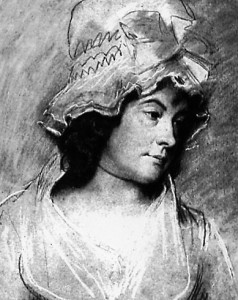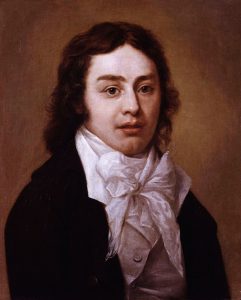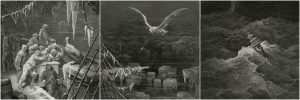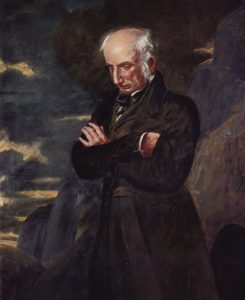Tuesday, October 3rd
Finish reading “The Age of Romanticism” (LXX-LXXXIV) and “Reading Poetry” (at the very end of your Broadview anthology. Pay particular attention to “What is a Poem?”, “The Poem as Performance,” “Poetic Forms”, and “Rhythm and Scansion,” but throughout this section you will find a great deal of useful discussion of literary terms and their employment in analysis.
Charlotte Smith, Sonnet I (46), Sonnet XII. Written on the Sea Shore. — October, 1784, and “On being cautioned against walking on an headland overlooking the sea, because it was frequented by a lunatic” (48)
William Cowper, “The Castaway“
Samuel Taylor Coleridge, “Eolian Harp” (558-559)
Literary Terms: lyric poetry, sonnet, ode, stanza and Forms of Lyric Poetry
Thursday, October 5th
Coleridge, “Fears in Solitude” and “Frost at Midnight” (559-563)
Coleridge’s definition of the Poet:
“The poet, described in ideal perfection, brings the whole soul of man into activity, with the subordination of its faculties to each other, according to their relative worth and dignity. He diffuses a tone and spirit of unity that blends and (as it were) fuses, each into each, by that synthetic and magical powers to which we have exclusively appropriated the name of imagination. This power, first put in action by the will and understanding and retained under their irremissive, though gentle and unnoticed control reveals itself in the balance or reconciliation of opposite or discordant qualities: of sameness, with difference; of the general, with the concrete; the idea, with the image, the individual, with the representative…and while it blends and harmonizes the natural and the artificial, still subordinates art to nature; the manner to the matter; and our admiration of the poet to our sympathy with the poetry” (Oxford Collected Works 319)
Literary Terms: lyric poetry, ode
**
Tuesday, October 10th / Making Lyrical Ballads
William Wordsworth, “Advertisement,” “Goody Blake and Henry Gill” (357-360), “Lines Written in Early Spring” (363), “Expostulation and Reply,” “The Tables Turned” and “Lines Written a few miles above Tintern Abbey” (373-377)
Dorothy Wordsworth, “Grasmere — a fragment” and “Thoughts on my Sick-bed” (503-505)
Helpful links: The British Library page on Lyrical Ballads and Wordsworth Trust
A nineteenth-century painting of Tintern Abbey
Literary Terms: ballad, lyric poetry, ode
Verse forms of the Romantic Era
Thursday, October 12th / Wordsworth after 1798
W. Wordsworth, excerpts from Lyrical Ballads, 1800, 1802 (377-385)
Important Ideas in the Preface to Lyrical Ballads
“Resolution and Independence” (403-405) and “I wandered lonely as a Cloud” (408-410)
D. Wordsworth, from The Grasmere Journal, entries associated with “Resolution and Independence” and from April 15th, 1802 (Broadview 408)
**
Tuesday, October 17th/ Coleridge, Day Two
The Rime of the Ancient Mariner (564-575), but look also at excerpt from The Rime of the Ancyent Marinere in Seven Parts from Lyrical Ballads (563-64)
“Kubla Khan” (589-590)
from Biographia Literaria, Chapters 13, 14, and 17 (599-607) and from Table Talk, on [The Ancient Mariner] (607-608)
Literary Terms: ballad and ballad stanza
Thursday, October 19th/ Wordsworth and Coleridge: later work
Coleridge, “Dejection: an Ode” (586-587)
Wordsworth, “Resolution and Independence” (403-405)
**
Tuesday, October 24th
No writing prompt this week
Second Semester Exam
Description of Second Semester Exam
Thursday, October 26th /
Introduction to the Later Romantics
Timeline of the later Romantic period
George Gordon, Lord Byron, Dedication to Don Juan (830-832)
Percy Bysshe Shelley, “To Wordsworth” (921)
John Keats, Letter to George and Thomas Keats (1141-1142) and Letter to John Hamilton Reynolds (1142-1143)
Felicia Hemans, “To Wordsworth“
Literary Terms: ottava rima, epic simile, sonnet
Tuesday, October 31st
Byron, Excerpts from Childe Harold’s Pilgrimage, Canto Three (799-819)
Outline and Important Stanzas from Byron’s Childe Harold’s Pilgrimage III
From the preface to Canto I of Childe Harold’s Pilgrimage (1812)
“A fictitious character is introduced for the sake of giving some connexion to the piece; which, however, no pretension to regularity. It has been suggested to me by friends, on whose opinions I set a high value, that in this fictitious character, ‘Childe Harold’, I may incur the suspicion of having intended some real personage: this I beg leave, once for all, to disclaim — Harold is the child of imagination, for the purpose I have stated. In some very trivial particulars, and those merely local, there might be grounds for such a notion; but in the main points, I should hope, none whatever.”
“The stanza of Spenser, according to one of our most successful poets, admits of every variety. Dr Beattie makes the following observation: ‘Not long ago I began a poem in the style and stanza of Spenser, in which I propose to give full scope to my inclination, and be either droll or pathetic, descriptive or sentimental, tender or satirical, as the humour strikes me; for, if I mistake not, the measure which I have adopted admits equally of all these kinds of composition.’ — Strengthened in my opinion by such authority, and by the example of some in the highest order of Italian poets, I shall make no apology for attempts at similar variations in the following composition; satisfied that, if they are unsuccessful, their failure must be in the execution, rather than in the design sanctioned by the practice of Ariosto, Thomson, and Beattie.”
Literary Terms: epic and Spenserian stanza
**




